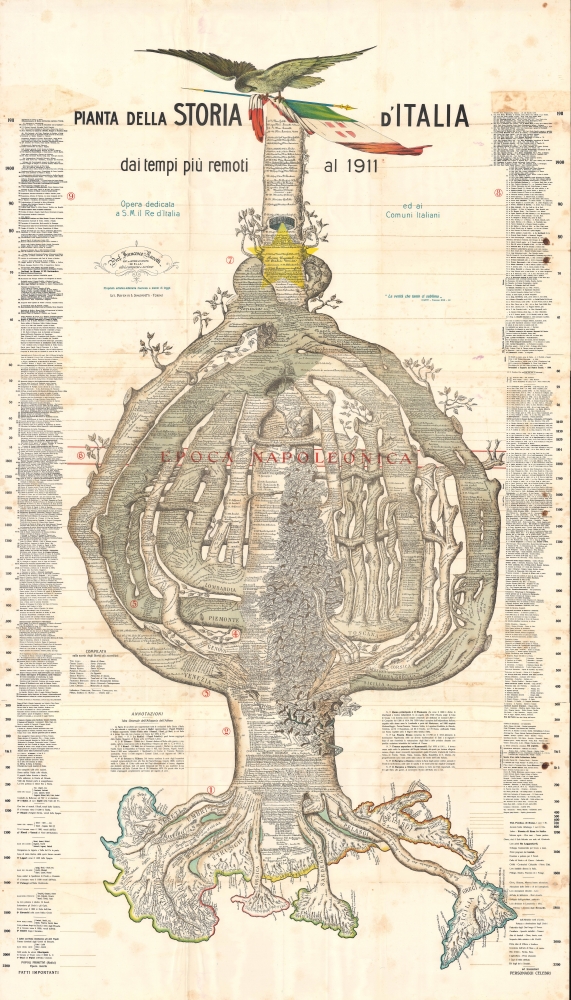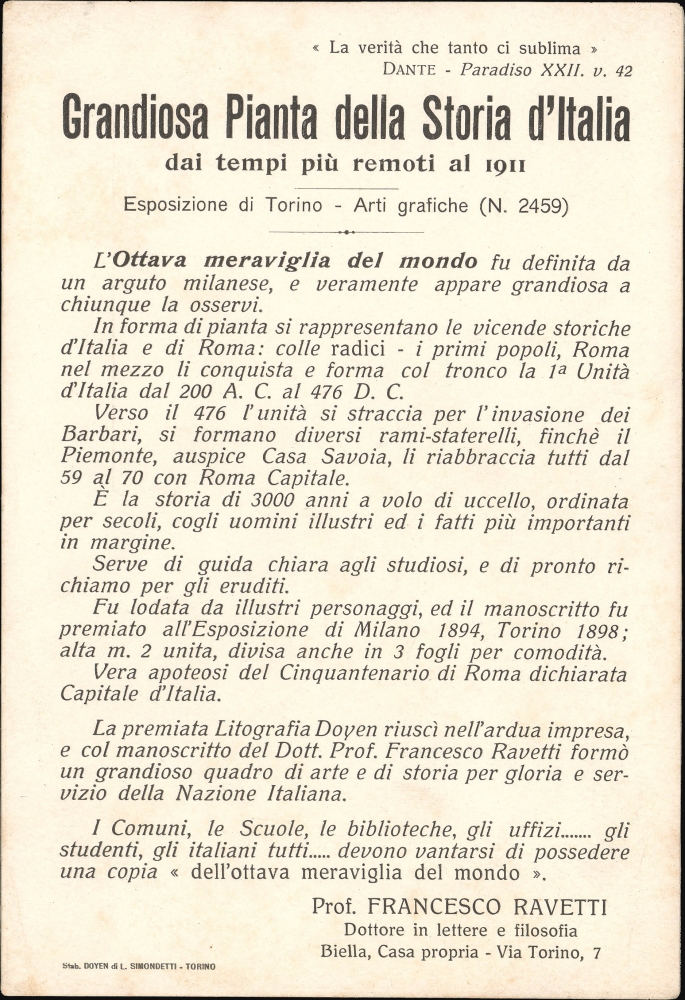This item has been sold, but you can get on the Waitlist to be notified if another example becomes available, or purchase a digital scan.
1911 Ravetti Huge 'Tree' Chart of Italian History
PiantaStoriaItalia-ravetti-1911$600.00

Title
Pianta Della Storia d'Italia dai tempi piu remoti al 1911.
1911 (undated) 84.75 x 48.5 in (215.265 x 123.19 cm)
1911 (undated) 84.75 x 48.5 in (215.265 x 123.19 cm)
Description
A stunning, very large format c. 1911 chart or 'tree' of Italian history from the earliest times, prepared by Professor Francesco Ravetti and printed by Litografia Doyen di Luigi Simondetti.
The tree's roots resemble the Italian Peninsula itself, laid on its side, with ancient civilizations and settlements recorded. Notably, the map includes Trentino-Alto Adige and Corsica, neither of which were ruled by Italy but by Austria-Hungary and France, respectively. Similarly, near the top of the tree, small branches refer to Trento, Corsica, Trieste, Malta, San Marino, Ticino, and Nice, all targets of irridentist nationalists.
A group of leaves in the tree's center records every pope from St. Peter to Pius IX (additional Popes are mentioned near the top of the chart), a necessary but no doubt uncomfortable addition for the liberal and generally anticlerical intellectual leaders of unified Italy.
Beyond the tree itself, a column of dates in the left margin traces important events; a column in the right margin notes important historical personages. Areas of discoloration above the columns are likely the result of pastedowns correcting errors that have since fallen off. Additional text lists Ravetti's sources and adds annotations, referring to numbers at various points on the tree.
Though Italy was (re)unified, there were still vast differences in language, culture, and wealth between its various regions, as well as powerful separatist movements. The architects of unification now needed to use modern media and symbolism to create a shared sense of patriotism among the mostly rural agrarian population. As the statesman Massimo d'Azeglio (1798 - 1866) quipped, 'We have made Italy, now we must make Italians.' In addition to standardizing dialects, promoting shared customs and holidays, and building infrastructure to connect the disparate towns and villages of the Italian Peninsula, the education system was critical in spreading literacy and a shared set of values for the country's youth. This historical chart fits within this trend, retroactively projecting a long history of 'Italy' into the past, when for most of that history, the term was, at best, a loose geographic or cultural referent.
A Closer Look
This chart was published to coincide with the fiftieth anniversary of the creation of the Kingdom of Italy and was distributed to schools for educational purposes. It begins at the top with the present (for Ravetti), listing the prime ministers and monarchs of the Kingdom of Italy, with a large star over the designation of Rome as the kingdom's capital in 1871 (discussed below). Though with a greater emphasis on recent events (the mid-late 19th century), the tree's branches and trunk cover the Napoleonic period, the early modern era, the Renaissance and Middle Ages, ancient Rome, and the pre-Roman civilizations.The tree's roots resemble the Italian Peninsula itself, laid on its side, with ancient civilizations and settlements recorded. Notably, the map includes Trentino-Alto Adige and Corsica, neither of which were ruled by Italy but by Austria-Hungary and France, respectively. Similarly, near the top of the tree, small branches refer to Trento, Corsica, Trieste, Malta, San Marino, Ticino, and Nice, all targets of irridentist nationalists.
A group of leaves in the tree's center records every pope from St. Peter to Pius IX (additional Popes are mentioned near the top of the chart), a necessary but no doubt uncomfortable addition for the liberal and generally anticlerical intellectual leaders of unified Italy.
Beyond the tree itself, a column of dates in the left margin traces important events; a column in the right margin notes important historical personages. Areas of discoloration above the columns are likely the result of pastedowns correcting errors that have since fallen off. Additional text lists Ravetti's sources and adds annotations, referring to numbers at various points on the tree.
Risorgimento - the Unification of Italy
Risorgimento, meaning 'resurgence' or 'revival,' was the long process of unifying (or perhaps reunifying) the Italian Peninsula in the 19th century. As with Germany and other potential nations lacking a state, the cause of unifying speakers of a common language and practitioners of a common culture was primarily taken up by educated urban liberals. The post-Napoleonic order tried to reestablish monarchical control, but uprisings throughout the 19th century weakened states such as the Bourbon Kingdom of the Two Sicilies and the Habsburg Kingdom of Lombardy-Venetia. A revolutionary movement led by Giuseppe Garibaldi was powerful in the southern part of the peninsula, while the Savoyard Kingdom of Sardinia (and Piedmonte) pressured Austria-Hungary in the north. In 1861, the Kingdom of Italy was proclaimed with Victor Emmanuel II as sovereign, though the kingdom lacked Venice and the Papal States, major targets of nationalists. Venice was annexed in 1866 after the Third Italian War of Independence, which coincided with the Austro-Prussian War. Rome remained occupied by the Second French Empire. However, Napoleon III recalled the garrison to help fight the Franco-Prussian War, which allowed the Italian Army to take control in 1870 and officially make Rome the capital of a unified Italy the following year.Though Italy was (re)unified, there were still vast differences in language, culture, and wealth between its various regions, as well as powerful separatist movements. The architects of unification now needed to use modern media and symbolism to create a shared sense of patriotism among the mostly rural agrarian population. As the statesman Massimo d'Azeglio (1798 - 1866) quipped, 'We have made Italy, now we must make Italians.' In addition to standardizing dialects, promoting shared customs and holidays, and building infrastructure to connect the disparate towns and villages of the Italian Peninsula, the education system was critical in spreading literacy and a shared set of values for the country's youth. This historical chart fits within this trend, retroactively projecting a long history of 'Italy' into the past, when for most of that history, the term was, at best, a loose geographic or cultural referent.
Publication History and Census
This historical chart was prepared by Professor Francesco Ravetti and printed in Turin by Lit. Doyen di L. Simondetti around the year 1911. A 1900 article in La Rassegna nazionale indicates that Ravetti had been working on the Italian history 'tree' since at least 1899 (which also seems to be the year he received his doctoral degree from Università di Torino), though it is unclear when or if it was printed before the c. 1911 publication seen here. In any event, all recorded surviving examples are dated c. 1911. The map is noted among the institutional holdings of the Università Cattolica del Sacro Cuore and Università di Siena and is scarce to the market.Condition
Good. Three sheets joined. Light wear along original folds. Soiling throughout. Several dark spots along right border.
References
OCLC 1347286502.








